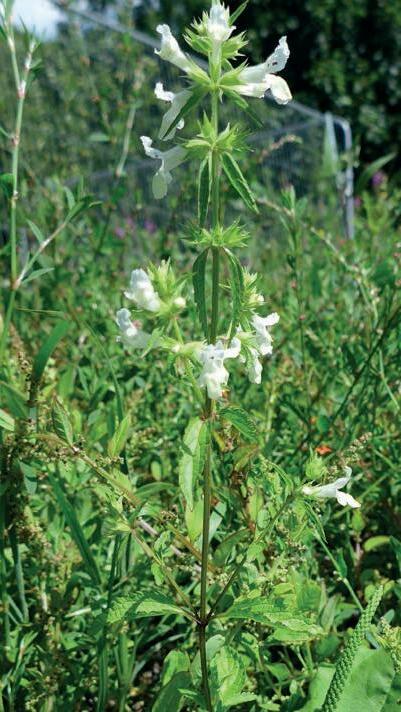
20 minute read
Compiled by Matthew Berry
ADVENTIVES AND ALIENS
Adventives and Aliens News 25
Advertisement
Compiled by Matthew Berry
Flat 2, Lascelles Mansions, 8–10 Lascelles Terrace, Eastbourne BN21 4BJ
m.berry15100@btinternet.com
Before passing onto the latest compilation, I would like to share a few observations from Eastbourne in 2021 if I may, in case they might be of more general interest as a possible indication of future trends or to give food for botanical thought.
In September I was surprised to find nonflowering plants of Pennisetum petiolare and Arthraxon hispidus (Small Carpet-grass) in Addingham Road in the Seaside area of Eastbourne (both conf. E.J. Clement). The first was sprouting in a tuft from a broken kerbstone, the second formed a very small prostrate mat on a dropped kerb of the pavement directly in front of the entrance to a property. There were also a few non-flowering plants of Guizotia scabra subsp. schimperi at the base of a wall and the foot of a lamppost. Both of the grass species have appeared in recent compilations for this section but these reports and others have tended to involve plants that were obviously very closely associated with bird tables and/or feeders, often actually in gardens. This was not the case in Addingham Road, although no doubt that bird seed was their source.
For the second time in the space of a few years, I found a self-sown plant of Lathyrus odoratus (Sweet Pea) in 2021, growing in the gutter of Channel View Road also in the Seaside area and not far from a garden where flowering Sweet Peas often take pride of place in high summer. If it is to become a more familiar sight as a ‘street weed’, it might be worth noting that at an early stage characters such as the winged stem and wavy leaflet margins are not necessarily that obvious. The leaflets, stems and stipules will probably be hairy, however, and as indicated in Poland & Clement (2020), these hairs have swollen bases. It also seems that a proportion of hairs fail to develop and when the light catches them under a lens, these swellings can then resemble tiny sessile glands.
In the introduction to Adventives & Aliens News 22, I wrote a little about Iberis amara (Wild Candytuft) as a constituent of wild flower seed mixes. Not long afterwards I sent flowering material I had collected from a wild flower seed mix to Eric Clement. He could not confirm that it was identical to the I. amara found as a native in this country, leaving open the possibility of a non-native infraspecific taxon such as Iberis amara var. coronaria (D. Don) Voss, or even a hybrid with a non-native species such as Iberis gibraltarica L. This year I was able to send him fruiting material from the same source and he thought it a very good match for our native I. amara. Even so, the situation might not be as straightforward as I implied, and the white-flowered, annual Iberis found in these mixes might not always be exactly the same as the plants that make up our native populations.
V.c.6 (N. Somerset)
Stachys annua (Annual Yellow-woundwort). Radstock Railway Sidings (ST69085470), 12/7/2020, H.J. Crouch, J.M. Crouch & P. Watson: one plant on waste ground on former disused railway sidings, now the edge of a housing estate. The second v.c.6 record and the first since 1908 at Portishead Station yard. An erect Eurasian annual (Lamiaceae) with cream corollas and a rare casual in Britain, brought in for example with grain and oil-seed. ‘Formerly established in abundance on the downs in W. Kent’, Clement & Foster (1994). Stace (2019): 657.
Tanacetum macrophyllum (Rayed Tansy). Frome (ST777478), 28/6/2021, H.J. Crouch & V. Graham: in waste ground below boundary wall of churchyard, St. John’s Church. It is not thought to have been
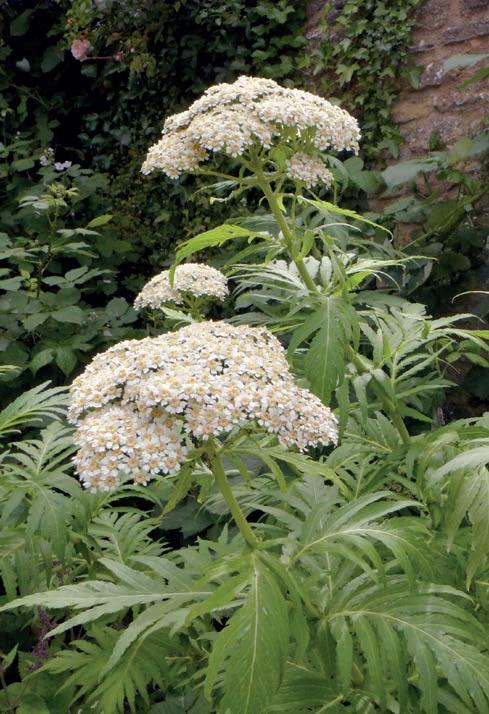
Left: Stachys annua, Radstock; right: Tanacetum macrophyllum, Frome, North Somerset (v.c. 6). Helena Crouch
planted and might have escaped from a large, neighbouring garden. A rhizomatous, perennial garden plant (Asteraceae) to 120cm, native to southeast Europe and south-west Asia, with 1–2 pinnately lobed leaves and white, rayed capitula; ‘known since 1912 at Jervaulx Abbey (v.c.65)’, Clement & Foster (1994), it was last formally recorded there in 2010. Confused with other species in the past, it seems at least one well-known nursery might be supplying it as Achillea chrysocoma ‘Grandiflora’. My limited researches suggest that A. chrysocoma is a more compact, yellow-flowered rockery plant with a similar native distribution. Clement et al. (2005): 325. Stace (2019): 788.
V.c.9 (Dorset)
Cyrtomium fortunei (Fortune’s Holly-fern). Canford Cliffs (SZ05898952), 7/10/2021, D. Leadbetter (det. F. Rumsey): one shuttlecock on bare ground near Martello Towers. An east Asian native (Dryopteridaceae) cultivated as an ornamental and less tender than C. falcatum (House Holly-fern). It has more pairs of smaller, more toothed pinnae per frond than the latter species. Stace (2019): 35. Aronia arbutifolia (Red Chokeberry). Near Broadstone (SY98889559), 10/9/2021, D. Leadbetter: several in Stonecrop Wood, where first recorded c.10 years ago. Red berries separate it readily from A. melanocarpa (Black Chokeberry) and A. × prunifolia when in fruit. Poland & Clement
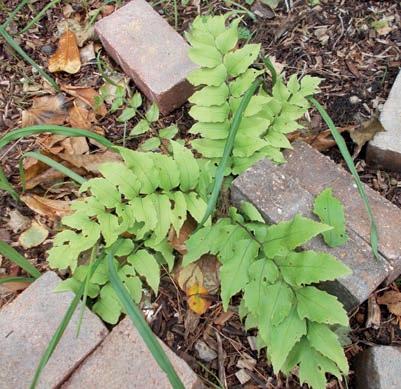
Cyrtomium fortunei, Canford Cliffs, Dorset (v.c. 9). David Leadbetter
(2020) distinguish it from the former by the more elliptic leaves with much hairier lower surfaces. Stace (2019): 230.
V.c.10 (Isle of Wight)
Pennisetum villosum R. Br. ex Fresen. (Feathertop). East Cowes (SZ502959), 11/2020, P. Stanley: well naturalised, kerb by side of car park, a long way from any garden. A perennial grass native to northeastern Africa, grown as an ornamental and known for its long-bristly, white, plumose panicles. There are only a few records in the DDb, the earliest from 2006. I also found a self-sown plant in a road gutter in Rylstone Road (TV62189969), Eastbourne in 2021 (conf. E.J. Clement).
V.c.11 (S. Hants)
Tropaeolum ciliatum Ruiz & Pav. Brockenhurst (SU2902), 6/7/2021, D. Leadbetter (conf. E.J. Clement): invasive in garden hedge, Rhinefield Road. The owner informed David Leadbetter that the plant had appeared in the garden without having been knowingly introduced and has thus far proved impossible to eradicate. Wishing to make it as irresistible as they can, Plant World Seeds wax lyrical about how ‘from the leaf axils of the thin branching stems spring countless blood red-veined yellow flowers amidst attractively lobed delicate leaves’. They describe it as being a hardy perennial climber from the high Andean mountains, ideal for climbing through a dwarf conifer or on a climbing frame, note that it makes a perennial tuber and is easier to grow than the red-flowered T. speciosum (Flame Nasturtium). Another website describes it as a very vigorous hardy climber and a native of shady gullies around Santiago (Chile); and states that after a slow first year ‘it can rapidly make 10–15m of growth in rich soil’, and that ‘it will travel underground extensively’.
V.c.12 (N. Hants)
Scrophularia vernalis (Yellow Figwort). St. Giles Hill (SU49072934), 25/3/2021, T. Norton: one large flowering clump in cemetery. A biennial Eurasian native (Scrophulariaceae) which can be a very persistent garden escape. Young plants of S. vernalis could be confused with the west Asian S. chrysantha Jaub. & Spach, which might also occasionally be in cultivation. However, the latter has more densely rounded inflorescences (c.2.5cm × 3cm). Stace (2019): 643.
Hedera helix subsp. poetarum (Yellow-berried Ivy). Aldershot (SU85795002), 9/4/2021, F. Rumsey: on corner of Ayling Hill and Ayling Lane, and in Ayling Lane itself (SU85824996). A Mediterranean native (Araliaceae) that is sometimes grown in gardens. Stace (2019): 840.
V.c.13 (W. Sussex)
Silene baccifera (Berry Catchfly). Wick (TQ02630348), 2021, D. Donovan (comm. N. Sturt): two plants on verge by the exit from Morrisons, Lyminster Road, soon cleared. A scrambling, well-branched, hairy perennial (Caryophyllaceae) to 2m, with greenish-white bell-shaped flowers. Until recently it was segregated as Cucubalus on the strength of its fruit being a black berry rather than a capsule. The classic site is in and around Merton (v.c.28), where it is supposed to have been introduced from eastern Europe as an additional food source for the local pheasant population. A native of Eurasia and North Africa, its typical habitats include hedges, banks and
woods. It also has limited availability as an unusual garden plant. Stace (2019): 501.
V.c.14 (E. Sussex)
Portulaca grandiflora hort., non Hook. (Rose-moss). Eastbourne (TV59379950), 10/8/2021, M. Berry: several plants at the foot of a wall, in pavement cracks and road gutter, Salehurst Road. The second Sussex record, the first being for Yapton (v.c.13) in 1996 (D.M. Donovan). A spreading annual garden plant (Portulacaceae) native to eastern South America. The fleshy stems and succulent cylindrical leaves resemble those of certain members of Aizoaceae, but the structure of the red, pink, yellow or white (often semi-double) flowers (up to c.5cm across) clasped between two blunt sepals and the transversely dehiscent capsules indicate the correct family. The persistent hair-like stipules are also distinctive.
Solanum pseudocapsicum (Winter-cherry). Eastbourne (TV61959945), 10/10/2021, M. Berry: one self-sown plant at base of wall behind lamp post, St. Aubyn’s Road. A perennial house plant and sewage waste casual, native to eastern South America. It can be more or less glabrous or sport a variable indumentum of branched hairs. Before the berries form, it is perhaps best distinguished from Capsicum annuum (Sweet Pepper) by the more divided calyx and the anthers with apical pores, if the stem base is not yet obviously woody. The first record for v.c.14 and the second for Sussex as a whole. Stace (2019): 611.
Helichrysum petiolare (Silverbush Everlastingflower). Eastbourne (TV61209926), 12/7/2021, M. Berry (conf. E.J. Clement): one seedling in angle between wall and footpath, pedestrian cut-through between Ashford Road and Junction Road, self-sown from a back garden. It seems to be the first Sussex record. A scrambling evergreen shrub (Asteraceae) native to South Africa and widely cultivated. A thick white tomentum is usually present, particularly at the apex of this seedling, otherwise as a street weed it might blend in surprisingly well with ubiquitous Parietaria judaica (Pellitory-of-the-wall). The leaves are actually much more obtuse and lack the translucent dots of that species. It is a naturalised alien of various habitats in some more western v.cc., and more generally an infrequent casual garden escape. It is viewed as a troublesome invader in other parts of Europe, e.g. northern Spain. Stace (2019): 773.
Erigeron annuus (Tall Fleabane). Hastings (TQ82840979), 26/7/2021, J. Rose (conf. M. Berry): three plants crowded together in a paving crack against a garden fence at the turning point in Tackleway, Old Town. There was no sign of the species in any nearby garden. It is the second record both for E. Sussex and Sussex as a whole. See Adventives & Aliens News 22, v.cc. 14 and 17. Stace (2019): 783–784.
V.c.15 (E. Kent)
Paulownia tomentosa (Foxglove Tree). Finglesham (TR33895318), 2/8/2020, O. Leyshon (conf. S. Buckingham): seedling in junction of kerb and road surface at Fowlmead. The first v.c. record. A second
Erigeron annuus, Hastings, East Sussex (v.c. 14). Jacqueline Rose
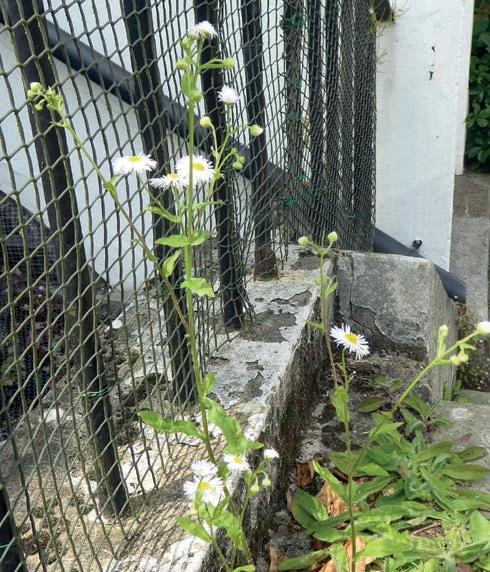
was made by Danny Chesterman two months later in Faversham. No doubt the winged seeds have always dispersed themselves effectively, the more suitable conditions for their formation/germination are a recent development. See Adventives & Aliens News 23, v.c.13. Stace (2019): 680.
Galactites tomentosus (Mediterranean Thistle). St. Margaret’s at Cliffe (TR36234419), 11/7/2020, O. Leyshon: six plants on dry, grassy roadside verge, Lighthouse Road. Second record for v.c.15, the first from 2014. Kent Botany 2020, p.14 (including photos). See Adventives & Aliens News 21, v.c.9. Stace (2019): 732.
V.c.16 (W. Kent)
Cotula coronopifolia (Buttonweed). Crayford Marshes (TQ5376), 23/7/2020, G. Kitchener: flowering in a depression. New to this 10 km-square and spreading in the north Kent marshes area. This is very much the damp, saline habitat where it has established elsewhere in Britain. Stace (2019): 799.
V.c.27 (E. Norfolk)
Scorzonera hispanica (Garden Scorzonera). North Walsham (TG30013267), 19/10/2021, S. Pryce: a single plant on a road verge. The first Norfolk record. A Eurasian perennial (Asteraceae) grown in gardens and allotments as a root vegetable and sometimes a persistent escape from them. There have been eight post-2000 records, two for v.c.14 and one each for v.cc.11, 16, 17, 24, 37 & 40. Stace (2019): 743.
V.c.28 (W. Norfolk)
Dichondra micrantha (Kidneyweed). Holkham NNR (TF87964520), 10/5/2021, M. Crewe: a large, wellestablished patch beside coastal track in stabilised dune grassland. The first Norfolk record. A prostrate, East Asian perennial (Convolvulaceae) rooting at the nodes with reniform leaves and solitary axillary flowers. The American D. argentea Humb. & Bonpl. ex Willd., a favourite of hanging baskets, has silky, silvery upper leaf surfaces (vs green and more or less glabrous in D. micrantha). The Australian/New Zealand D. repens Forster & Forster f. has sparsely hairy upper leaf surfaces. It also has somewhat larger corollas, longer fruiting pedicels that are more or less straight (strongly recurved in D. micrantha), longer sepals and fruits that do not exceed the calyx (fruits longer than calyx in D. micrantha). There are no confirmed records for Britain and Ireland. Although
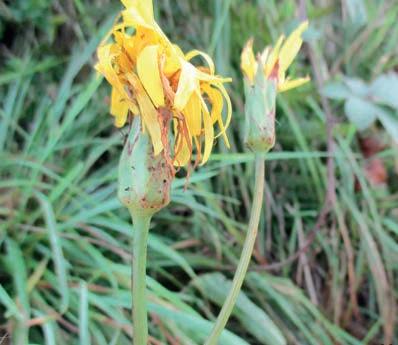
Scorzonera hispanica, North Walsham, East Norfolk (v.c. 27). Suki Pryce
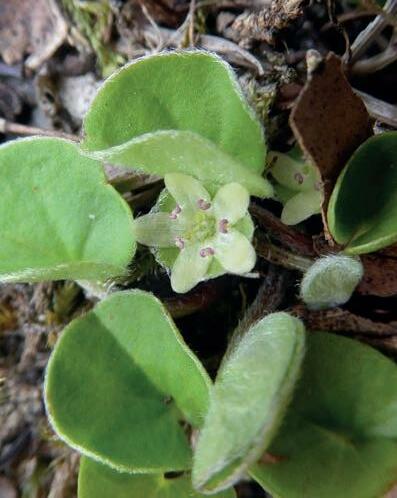
Dichondra micrantha, Holkham, West Norfolk (v.c. 28). Mike Crewe
we are some way from the situation in warmer parts of the world where D. micrantha is widely naturalised, it might be increasing, with other recent records for v.cc.77 (2017) and 86 (2019). ‘Established since 1955 on dunes near Hayle (v.c.1)’, Clement & Foster (1994), the last traceable record for it there is from 1979. Clement et al. (2005): 222, Stace (2019): 599.
V.c.50 (Denbs)
Jasminum beesianum (Red Jasmine). Trefydd Bychain (SJ20155054), 9/6/2021, D. Williams (comm. S. Tyler): single small plant in flower growing out of limestone outcrop in mixed ash woodland on private land. There are no other v.c.50 records in the DDb. A native of China (Oleaceae) which has only become a more popular garden shrub relatively recently. This occurrence has every appearance of having been naturally dispersed by a bird or a small mammal. Delyth Williams found what she thinks must be the original parent plant in a garden 50 to 100m away (pers. comm.). Stace (2019): 614.
V.c.52 (Anglesey)
Potentilla indica (Yellow-flowered Strawberry). S of Beaumaris (SH58177419), 18/6/2021, G. Vaughan (comm. S. Tyler): several plants on roadside. It was first noticed in 2018. The only v.c.52 record of the species in the DDb. See Adventives & Aliens News 17, v.c.58. Stace (2019): 271.
Alstroemeria aurea (Peruvian Lily). Mynydd Mechell (SH35458913), 22/6/2021, N. Brown: in trackside vegetation. The only v.c.52 record of species in DDb. A spreading tuberous perennial garden plant (Alstroemeriaceae) with slightly zygomorphic flowers from Chile and Argentina. The flowers of A. aurea (in its typical form at least) are orange with red spots and streaks. It is perhaps less likely as a garden throw-out because its delicate root system is easily damaged and it is particular about the depth of planting. The pot-like capsules produce many largish, globose seeds, however. An odd feature of this species is that the petioles are twisted through 180 degrees, so the leaves are resupinate (i.e. the lower leaf surfaces are actually uppermost). At one time it looked as if A.aurea might be supplanted in gardens by Alstroemeria hybrids, the so-called ‘Ligtu Hybrids’ after one of the parent species. Perhaps cultivars of A. aurea now adequately supply the demand for novelty. It is or was an ‘established garden escape; well naturalised in damp places in the Greeba Curraghs, near St. John’s (v.c.71) and in several places in Scotland’, Clement & Foster (1994). Clement et al. (2005): 433. Stace (2019): 898.
V.c.57 (Derbys)
Chenopodium berlandieri (Pitseed Goosefoot). Barlborough (SK4776), 8/8/2021, M. Lacey (conf. J. Akeroyd): on waste ground opposite McDonalds (see photographs on next page). The seeds were pitted and with rounded edges quite unlike those of C.album; the red-striped stems and dark green leaves help to distinguish it from C.suecicum which has a similar pitting pattern on its seeds. The Barlborough plant had noticeably keeled tepals too, which also fits C. berlandieri. A grain, oil-seed casual and former wool alien from North America and Mexico. Stace (2019): 517.
Chenopodium bushianum (Soyabean Goosefoot). North of Shirebrook (SK518699), 12/9/2021, M. Lacey (conf. J. Akeroyd): in a maize field (see photographs on next page). Like C. album overall but the large seeds (2mm × 1mm) lacking acute edges pointed the way to the final determination. Mick Lacey also noted that the seeds were pitted and slightly furrowed. John Akeroyd made additional mention of the paniculate, leafy inflorescence drooping at the tips, as being rather more characteristic of C. bushianum than of C.album (Fat-hen) and the remarkably similar C. berlandieri (Pitseed Goosefoot). The large seeds also apparently help to distinguish it from certain forms of C. suecicum (Swedish Goosefoot). A casual alien of tips and waste ground from North America, particularly associated with soyabean waste. Stace (2019): 517.
V.c.63 (S.W. Yorks)
Rumex crispus L. subsp. robustus (Rech.) Pestova (Curled Dock). Rossington area (SK64579867), 15/7/2021, D.A. Broughton (conf. G. Kitchener): c.10 plants, shady hedgebank on heavy soil, Warren
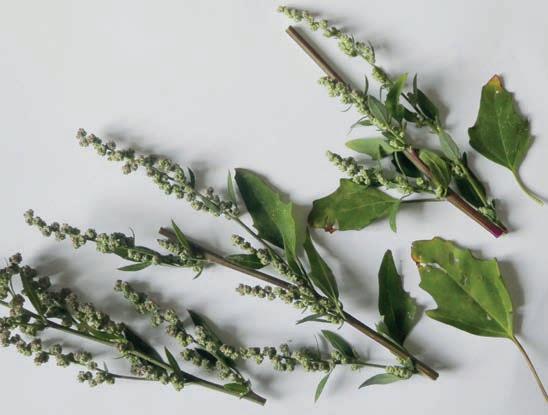
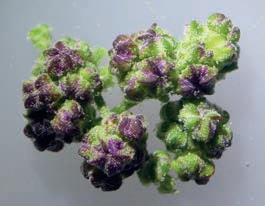
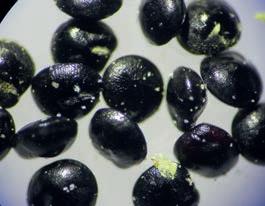
Chenopodium berlandieri, Barlborough, Derbyshire (v.c. 57), with flowers and seeds. Mick Lacey
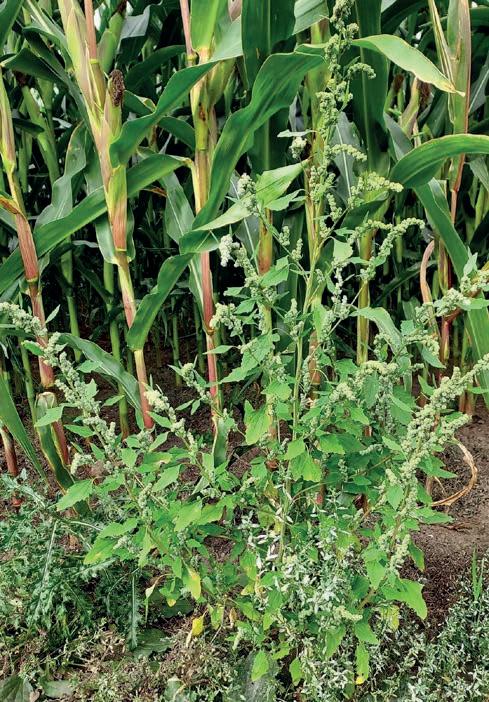
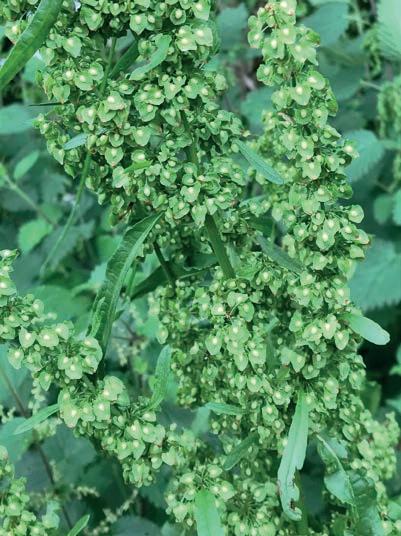
Above: Rumex crispus subsp. robustus, near Rossington, South-West Yorkshire (v.c. 63). David Broughton
Left: Chenopodium bushianum, near Shirebrook, Derbyshire (v.c. 57) with larger seeds compared to those of C. album (inset). Mick Lacey
House Farm. There were also more than 10 plants at SK64619854, growing in ruderal vegetation on a disturbed ditch bank at the edge of an arable field, on a drainage-impeded, sandy-loam substrate, also Warren House Farm. This is an area where much grain has been scattered as pheasant feed and also lying near site of a former airfield, now Donacaster/ Sheffield Airport. David Broughton was struck by these Curled Dock plants which were ‘unusually tall (over 1.3m) and robust, with broad leaves, a huge inflorescence, large tepals and unusual dark green colouration’. According to the account in Manual of the Alien Plants of Belgium, this taxon seems almost to have affinities with R. patientia (Patience Dock) that are not evident in the nominate subspecies. For more information on the Rossington site, see botanyhuntsyorks.blogspot.com/2021/08/rumex-crispussubsp-robustus.html; and for details of a recent v.c.16 record, see Kent Botany 2019, p.33.
Hedera algeriensis ‘Gloire de Marengo’ (Algerian Ivy). Mickletown (SE38682730), 14/2/2021, D.A. Broughton: escape/planting at level crossing, Station Road. The leaves of this cultivar have creamy-white margins. See Adventives & Aliens News 22 for a v.c.62 record also at a railway crossing. Stace (2019): 840.
V.c.64 (M.W. Yorks)
Cicer arietinum (Chick Pea). Apperley Bridge (SE19483792), 21/9/2021, M.P. Wilcox (comm. D. Broughton): one plant on river shingle by River Aire, downstream of a major sewage treatment works at Esholt. The only modern v.c.64 record in the DDb. See Adventives & Aliens News 20, v.c.29. Stace (2019): 174.
Hedera algeriensis ‘Ravensholst’ (Algerian Ivy). Temple Newsam (SE35793284), 4/4/2021, D.A. Broughton: extensive up trees and over woodland floor, North Plantation. The leaves of this cultivar can assume a purple tinge in winter.
Hosta ‘Undulata Albomarginata’ (A Plantain Lily). Lumby (SE47273023), 15/8/2021, D.A. Broughton: area where spoil and garden waste has been tipped, Red Hill Lane. Hosta are rhizomatous perennials (Asparagaceae) cultivated primarily for
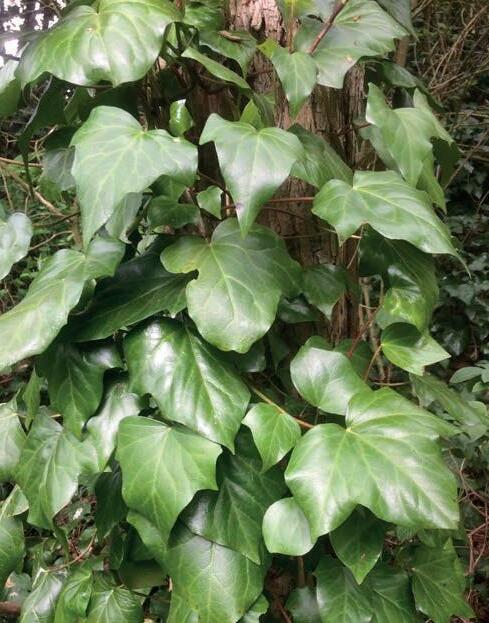
Hedera algeriensis ‘Ravensholst’, Temple Newsam, Mid-West Yorkshire (v.c. 64). David Broughton
their distinctive, stalked, ribbed leaves rather than their generally unimpressive racemes of funnelshaped, six-lobed flowers of various often rather pale shades of mauve or violet-purple. This cultivar is probably of hybrid origin, not a good species, and unlikely to produce viable seed. Plantain Lilies were formerly known by the generic name of Funkia and might still be referred to as such by some in the horticultural trade. They are natives of northeastern Asia.
Allium siculum subsp. dioscoridis (Honey Garlic). Ben Rhydding (SE13224689), 12/6/2021, D.A. Broughton: one flowering clump, south of Wheatley Rakes. A bulbous perennial (Amaryllidaceae) native to southern Europe and Turkey, which occurs as a garden escape, sometimes becoming naturalised. Until recently it was placed in another genus, Nectaroscordum, because it has a semi-inferior rather
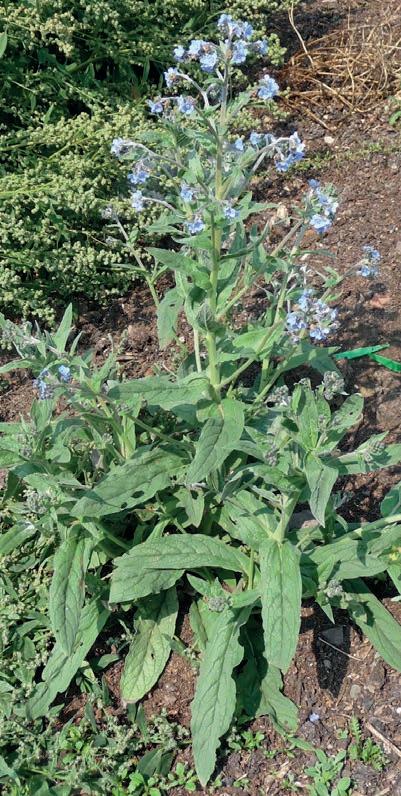
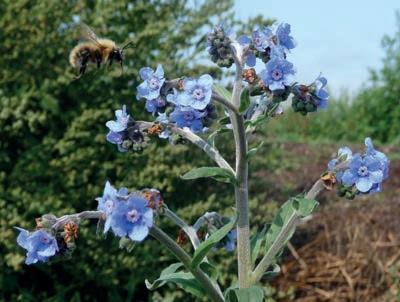
Cynoglossum amabile, Mungoswells, East Lothian (v.c. 82). Richard Milne than superior ovary. For a drawing of the rarer subsp. siculum, see Clement et al. (2005): 426. Stace (2019): 948.
V.c.82 (E. Lothian)
Cynoglossum amabile (Chinese Hound’s-tongue). Mungoswells (NT49378050), 25/8/2021, R.I. Milne: on soil heap at side of field near ditch, with Chenopodium album (Fat-hen), Solanum tuberosum (Potato) and S. lycopersicum (Tomato), near Coldhame Wood. A rather tall (at least when well-grown), erect biennial garden plant (Boraginaceae) native to western China, with grey-green foliage and flowers resembling a very large Myosotis (Forget-me-not), c.8mm across. There are other recent records in the DDb for v.cc. 1 (2019), 2 (2019), 34 (2018), 63 (2019) and 94 (2018). See BSBI News 134, pp.47–48.
V.c.83 (Midlothian)
Urtica membranacea (Mediterranean Nettle). Edinburgh (NT32347131), 15/6/2021, R.I. Milne: one plant on side of soil mound with other weedy species, e.g. Urtica dioica (Common Nettle) and Conium maculatum (Hemlock), Whitehill Road. New to v.c.83. Stace (2019): 305.
V.c.94 (Banffs)
Downingia elegans (Californian Lobelia). Dufftown Golf Course (NJ30503918), 27/8/2021, J. Milne & I. McDonald (det. A. Amphlett & M.J. Crawley): one flowering/fruiting plant appeared in a small area cleared of vegetation by John Milne. It was likely introduced in grass seed as for most/all of the other British/Irish records. A blue-with-whiteflowered North American annual (Campanulaceae), like a Lobelia but with long, sessile ovaries rather than short pedicellate ones. The last British record was in 1998 (v.c.32), the last Irish record known to me was in 1994 (v.c.H39). This is the first for Scotland. It occurs ‘usually in damp hollows or by newly-made ponds’, Clement & Foster (1994). It also occurred at the edge of a reservoir in at least one of its localities (v.c.14). See BSBI News 23, p.11 for a full page drawing. Stace (2019): 706.
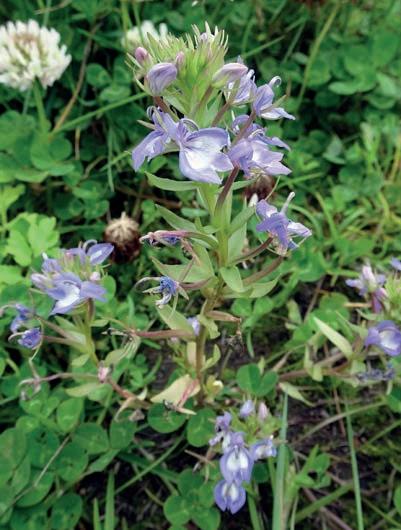
Downingia elegans, Dufftown, Banffshire (v.c. 94). Ian McDonald
V.c.95 (Moray)
Crocus kotschyanus (Kotschy’s Crocus). Grantown on Spey (NJ02722604), 25/10/2021, A. Amphlett (det. M.J. Crawley & I.P. Green): c.40 plants on southeast side of footpath, just beyond parking area by Inverallan graveyard. The second Scottish record. See Adventives & Aliens News 19, v.c.95. It was also recorded in Newhaven (v.c.14) in October 2020 (TQ45350138, det. M. Berry, record not in DDb). Stace (2019): 935.
Allium sphaerocephalon (Round-headed Leek). Fochabers (NJ34255891), 23/7/2020, A. Burgess (conf. I. Green): two flowering stems in grassy area by path at edge of cricket field. New to v.c.95. A supposed native (Amaryllidaceae) in the Avon Gorge (v.c.34) and sandy maritime habitat in Jersey, it is also a garden plant. Stace (2019): 948.
Bromus arvensis (Field Brome). Forres (NJ03565767), 18/6/2020, I. Green: one clump on east verge of old railway line, Dava Way. The first v.c.95 record since 1871. An annual grass from Eurasia found as a grain/agricultural seed alien of arable fields and as a wool adventive. It is also a rare casual of verges and waste ground. See Adventives & Aliens News 13, v.c.17. Stace (2019): 1089–1090.
V.c.97 (Westerness)
Cardamine heptaphylla (Pinnate Coralroot). N of Killiechonate (NN24078158), 17/4/2020, I.M. Strachan: a large flowering clump on bank of River Spean. An often white-flowered perennial garden plant (Brassicaceae) that is native in many European countries. It was formerly in the genus Dentaria, a reference to the tooth-like scale leaves on the fleshy rhizome of this and several other Cardamine species, also known formerly as Dentaria. See Adventives & Aliens News 16, v.c.69. Stace (2019): 425.
References
Clement, E.J. & Foster, M.C. 1994. Alien Plants of the British
Isles. Botanical Society of the British Isles, London. Clement, E.J., Smith, D.P.J. & Thirlwell, I.R. 2005. Illustrations of Alien Plants of the British Isles. Botanical Society of the
British Isles, London. Poland, J. & Clement, E.J. 2020. The Vegetative Key to the British
Flora (2nd edn). John Poland, Southampton. Ryves, T.B., Clement, E.J. & Foster, M.C. 1996. Alien grasses of the British Isles. Botanical Society of the British Isles,
London. Stace, C.A. 2019. New Flora of the British Isles (4th edn).
C & M Floristics, Middlewood Green, Suffolk.
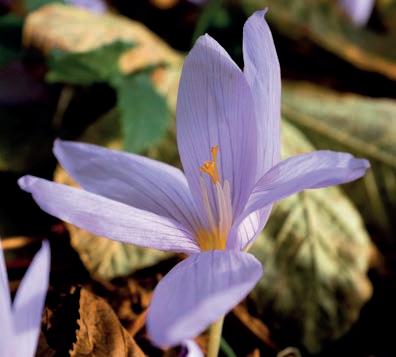
Crocus kotschyanus, Grantown on Spey, Moray (v.c. 95). Andy Amphlett










